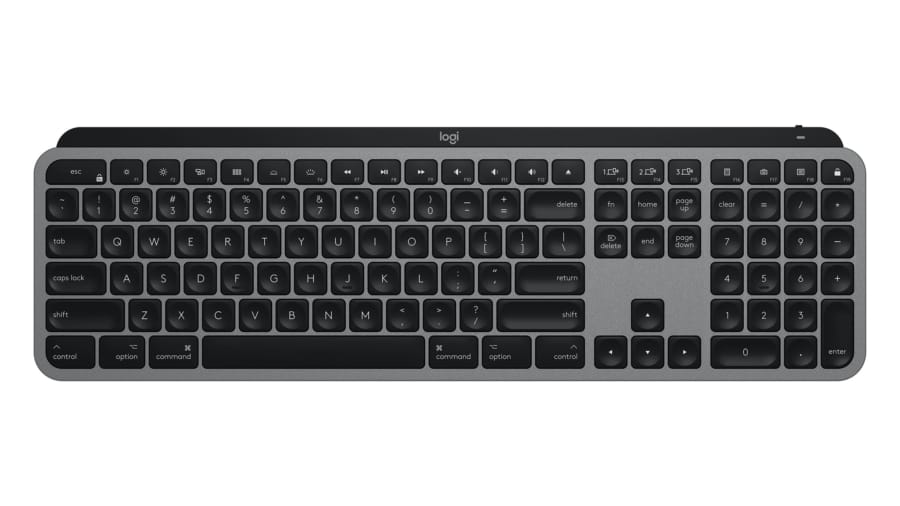MX Keys for Mac, after 3 Years
As some of you are aware, I have been a big proponent for Microsoft keyboards, especially its ergonomic lines. I had adored Microsoft Hardware products, until the market has shifted away from desktop, and the Seattle-based manufacturer decided to throw the flagship keyboard down the bus. My search for go-to Mac keyboard led to Logitech. I recall the brand synonymous at one point for experimental extended battery design, though it quickly got out of hand with ridiculous solar-powered keyboard.
Logitech often delivers good entry-level and mid-range products. A wireless keyboard powered from solar panels is not quintessentially a failed design. What Logitech, time and time again, fails is to deliver a proper keyboard. Logitech’s own ergonomic split keyboard, K860, looked appealing on first glance, much like the solar keyboard; however, keyboard layout —which Logitech has history of not emphasizing— was that of a half-desktop and a half-laptop. My experiences with Logitech-branded items suggest the company is far more conservative with new gimmicks on high end flagship models, whereas anything less has tendency to be used as a novelty item.
During my search for a new keyboard, abandoning split-type keyboard became more or less a necessity. Ergonomic keyboards are still rare breeds in the market, and I do not see why it would return anytime soon with the surge in demand for more portability, especially when most devices are now shipped with touchscreen keyboard. After all, Logi did its market research and ships only one split line. This placeholder product shows certain lack of attention: uncompromising island of a desk space it takes up, not so polished key layout, and num pads hanging like a dead weight as it hadn’t been touched from common full-size design. It’s like a guitar for left-handed, except the head position is still awkwardly kept right-handed.
This brings me to the story of trying out Logi’s —yes, the company did drop “tech”— a non-split desktop keyboard, MX Keys for Mac, for 3 years. Going back to traditional keyboard was both surprisingly pleasant and unexpectedly tiring. In its lightness, from the weight and flat form factor, MX Keys was portable on my desk. While it isn’t a portable bluetooth keyboard per se, it creates a modular workspace. A proper Mac layout is the cherry on the top. Had this been the only surprises, I would have written a piece recommending MX Keys in haste.
What Logi has managed to pull off came at the obvious price of not delivering a proper keyboard. The fatigues on the shoulder was much expected; I had prepared to compensate for non-split design, modular workspace being one of them. My single biggest gripe with MX Keys, as I am typing on MX Mechanical, is its key stiffness. Otherwise known as operation force, each keyboard comes with varying physical strength requirement to register a push. Inevitably this falls under personal preferences, but as a laptop-like keyboard, I expected the firmness of a keyboard similar to that of MacBook’s. Not only key presses were tough as a bad piece of steak, due to its slim design I would immediately hit the board. So my fingers had to suffer through the pain of bouncing back, much like toothache after chewing too hard.
These catchphrases, such as ‘compatible with Mac’ or ‘laptop-like’, are thrown around to insinuate at what range a product it sits at. And MX Keys, supposedly a high-end keyboard from the Swiss company, doesn’t fall far from the garden of marketing buzzwords. ‘Compatible with Mac’, for instance, can be used to described any range of keyboards, so long as it supports plug-and-play on humane level. What makes ‘laptop-like’ an even more infuriating techno jargon is that it is made out of another techno jargon. What is ‘the laptop’ a laptop-likeness trying to achieve? I naively assumed it must have meant mid-range laptop experience,(read: entry level MacBook) and I was more or less hit with the hardest scissor keyboard to type on.
Ironically what the Swiss company got right about the laptop-like keyboard is what I am disappointed in the most —how hard it is to clean them. Keys on MX Keys are separated individually with handsome amount of space keeping them apart. Each gap obviously collects dirt and debris as is used. Most keyboards, for this very reason, often allow users to pop the key caps, or design with enough tolerance to be cleaned. Neither is true for MX Keys: key caps are unremovable, and key cap clearance is barely big enough to collect dirt but not clean.
What puts me off further is its USBs and its disorganized ports. On the actual device itself, the keyboard is using USB-C to charge. However, on the host side of the business, Logi decided to include USB-A receiver. This design ‘philosophy’ or lack thereof plagues all Logi products as I understand it. Logi Bolt was launched with secure wireless I/O for business environment in mind, not a backward compatibility device for computers without Bluetooth or USB-C port. To say the least, Logi should have offered USB-C models. One can easily switch out a charging cable, but Logi Unifying Receiver or Bolt Receiver, both proprietary standard from the manufacturer, are only available in USB-A. Nowadays most laptops and desktops are shipped with at least one USB-C port, and for older machines, it’s possible to still use them with USB-A to USB-C dongle. There is no need to make a new “old”, or outdated on arrival, product.
My view on MX Keys for Mac, thus, is that this is purely experimental device. It is Logi’s attempt to replace Apple’s position, the de facto keyboard, in the Mac market. And the attempt fell short of being a great keyboard. For a keyboard launched with USB-C port, I still find it hilarious Logitech decided to include USB-A receiver with it.
